Building a strong brand is your best defense strategy in the digital age.
It’s like building a moat around your business. The deeper and broader you can build your brand moat, the stronger your business becomes.
Building a strong brand will protect your company from competitors and secure your assets. And brand performance allows you to determine precisely how strong your brand is.
In this guide, you’ll learn how to measure and optimize your brand performance so that you can grow a strong brand and profitable business.

Manage all your social media accounts in one place.
Craft, schedule, & auto-post content to all your social channels, then track analytics and manage interactions from a single, easy-to-use dashboard.
What is Brand Performance?
Brand performance is the measure of a brand’s results against the business and marketing goals.
While brand delivery focuses on how branding is executed during a marketing campaign, brand performance measures the campaign results to see how effective the branding was for the business.
And as each brand is different, performance varies considerably from one brand to the next.
How to Measure Brand Performance
Brand performance is typically measured using a combination of the following metrics.
Measuring Brand Performance Across Your Online Channels
You can measure your brand performance by tracking how well your brand is growing on social media. What people like, share, comment on, and subscribe to provides insights into how your brand is performing.
Audience growth
Audience growth refers to how many followers you have on your social media channels and the number of website visitors you get. You can track these on a monthly basis to see how your brand is performing.
On social media, you’ll want to check your account-level metrics. For example, on LinkedIn, that’s the number of followers your company page has:

You can track similar follower numbers on the other social networks.
On Google Analytics, you can track the number of monthly visits to your website:

Audience interactions
Audience interactions refer to the number of views, likes, retweets, shares, and comments you get on your social media and blog posts.

Again, these can be measured and tracked on a monthly basis to see if you have a positive trend. The level of these social engagement metrics indicates a weak or strong brand presence.
Brand penetration
Brand penetration refers to the number of people in a particular niche, demographic, or geographical location who choose to adopt a specific brand.
There’s only one KPI to measure: the number of people who use a brand’s products, divided by the total number of available people in the niche market.
For example, If we were calculating the brand penetration of two brands in a marketplace with a population of one million people:
- Brand A: 340,000 / 1,000,000 = 34
- Brand B: 210,000 / 1,000,000 = 21
Remember: this calculation is based on the number of people, not the number of dollars spent.
For example, both Google and Bing offer a free search engine, but you’d say that Google has a higher brand penetration as more people prefer to use their service.
Measuring Brand Performance Along the Buyer Journey
Measuring brand performance is not only about the number of social interactions and the number of visitors to your website. It also involves evaluating how potential customers move through your buyer journey.
Awareness
Brand awareness refers to the ability of a target audience to recognize or recall a brand or product accurately. If your target audience remembers your brand, they’ll likely keep coming back for more.
For example, most people could recognize the Apple brand, picture their logo, name one of their products, and perhaps share some information about what the brand stands for.
There are 3 KPIs to measure:
- Top of mind (TOM) brand awareness – for example, “When you think about cars, which brands come to mind?”
- Spontaneous brand awareness – for example, “I’m familiar with BMW and Toyota.”
- Prompted brand awareness – for example, “Which cars have you heard of on this list?”
The percentage of respondents who mention your brand first (unprompted) indicates your brand’s TOM awareness.
The percentage of people who mention your brand unprompted, but not necessarily first, indicates your spontaneous brand awareness.
And the percentage of people who recognize your brand on the list indicates your prompted awareness.
As well as asking market research questions about your brand, you can also track website visitors.
For example, you can see how many people know and recognize your brand by the number of direct visitors (those entering your website’s URL in their browser):
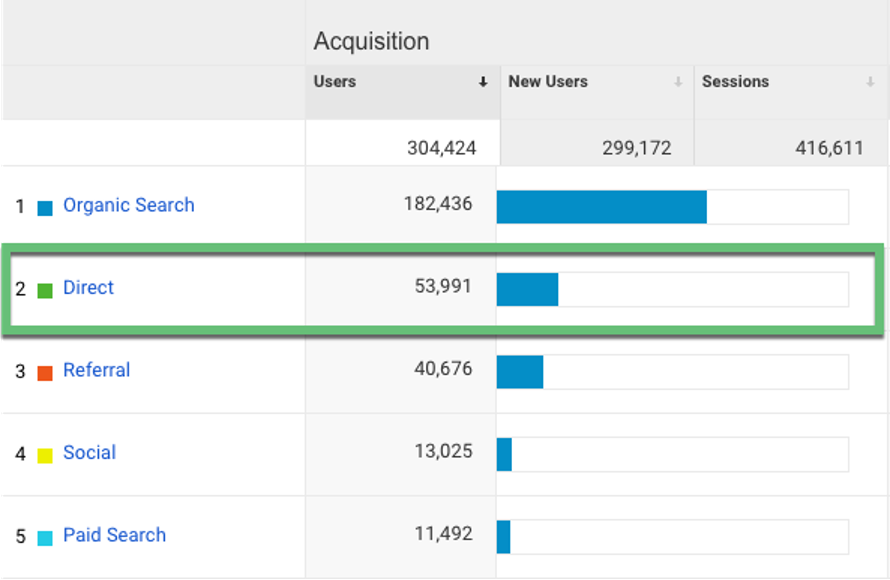
Established brands may get 50% direct traffic, while small up-and-coming brands get 20% direct traffic.
In this graph, you can see some of the top global brands get over 50% direct traffic:
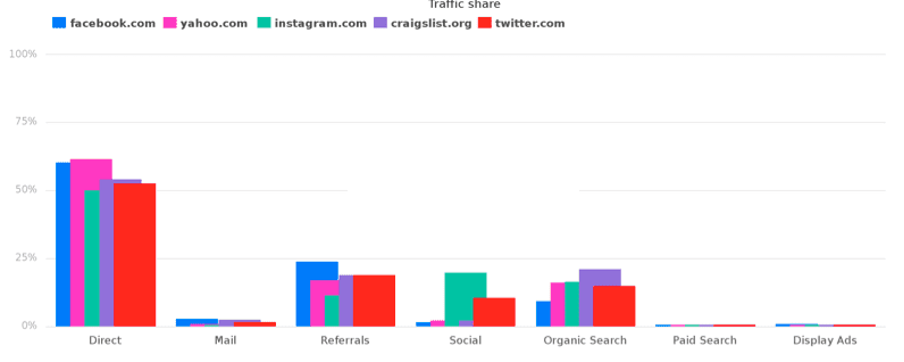
Familiarity (Knowledge)
Brand familiarity or knowledge looks at how well your target audience knows your brand, your products, and what you stand for. For example, they may have heard of your brand in passing, but they don’t know for sure what you do.
There are 2 KPIs to measure:
- Self-declared knowledge about the brand: When your target audience mentions your brand or products, what do they say about it and how much do they know about your brand story, values, and partnerships.
- Brand profile: What does your target audience know about your brand and products?
On your website analytics, you can check the bounce rate and average time-on-site of your visitors.
If the visitors know and understand what you do before they visit, then it’s highly likely they’ll spend longer on your site and navigate through several pages. This results in a high average time-on-site and a low bounce rate.

If the opposite is true, then it’s likely they’ll leave your site quickly, and your bounce rate will be high.
Consideration
Brand consideration looks at how much of your target audience actually wants to buy your product or services.
There’s only one KPI to measure, and that’s purchasing intent. You can find this by checking website engagement, interaction with marketing messages, and previous purchases. Or, you can simply ask people whether they would consider purchasing your product or brand.
In your analytics, you can track how many visitors click a specific button, such as “Buy Now” or “Contact,” with goals and events. These metrics indicate that users are interested in your product or service.
Hopefully, these figures should align with your sales figures. If they don’t, then you’ll need to examine your marketing to see why people don’t buy after showing their purchasing intent.
Purchase
The purchasing stage of brand awareness looks at how many people buy your product or service. In short, you’re looking at your sales figures.
There are 3 KPIs to measure:
- Volume: The demand for your products and services.
- Velocity: The speed a customer travels through the buying process.
- Value: The ability to sell at a premium price and avoid discounting.
Volume is measured by the number of leads your business generates each month. As Jeremy Miller says:
“Volume is a relatively easy metric to track, but it’s hard to move.”
For instance, a brand that dominates a niche makes three times the profit of the second-placed brand. And the number-three brand makes half the profit of the number-two.
Generating leads is one thing, but converting them is another.
Popular brands like Apple are fine.
According to the Wall Street Journal:
“Apple draws so many shoppers that its stores single-handedly lift sales by 10% at the malls in which they operate.”
But smaller brands have to market more aggressively to compete.
You can measure velocity by tracking how quickly customers move through your buyer journey. The quicker they move from the awareness stage to making a purchase shows your brand messaging is clear, and the desire for your brand is greater than your competitors. It’s a clear indicator of strong brand performance.
A simple way to monitor value is by tracking how much you have to discount your products or services. Strong brands like Apple don’t offer discounts. In fact, customers are prepared to pay a premium for their products.
If you have to discount to sell, then you’re selling on price rather than on value, and that’s an indicator of poor brand performance.
Advocacy
Brand advocacy is all about how many customers recommend your brand. In short, the number of referrals you are getting.
Brand advocates sell your brand to everyone for free, and they’re also a trusted source of information to potential buyers.
There are 2 KPIs to measure:
- Net promoter score (NPS): Use online surveys and questions to gather feedback.
- Social mentions: Track how many people are mentioning your brand on review sites, and check the sentiment behind those mentions.
For the NPS, ask your customers a simple question: “How likely are you to recommend our brand.”
Then, group the results into three buckets:
- 9-10 are promoters
- 7-8 are passives
- 0-6 are detractors
To calculate the final score, subtract the percentage of detractors from the percentage of promoters. For example, if you have 10% distractors, 60% passives, and 30% promoters, your NPS is 20.
The more promoters you have, the better, otherwise you risk getting a negative score.
You can track social mentions in a similar way, by subtracting the number of negative sentiments from positive remarks, and hopefully achieving a positive outcome.
Examples of Companies With Strong Brand Performance
According to brand consultancy firm Interbrand, the world’s leading technology and electronics brands make up 50% of the Top 10 best global brands in 2019:
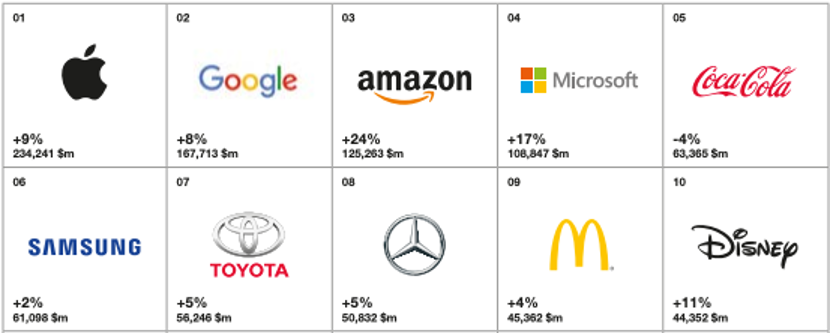
- Apple
- Amazon
- Microsoft
- Coca-Cola
- Samsung
- Toyota
- Mercedes
- McDonald’s
- Disney
Let’s take a look at three of the top performers.
Apple
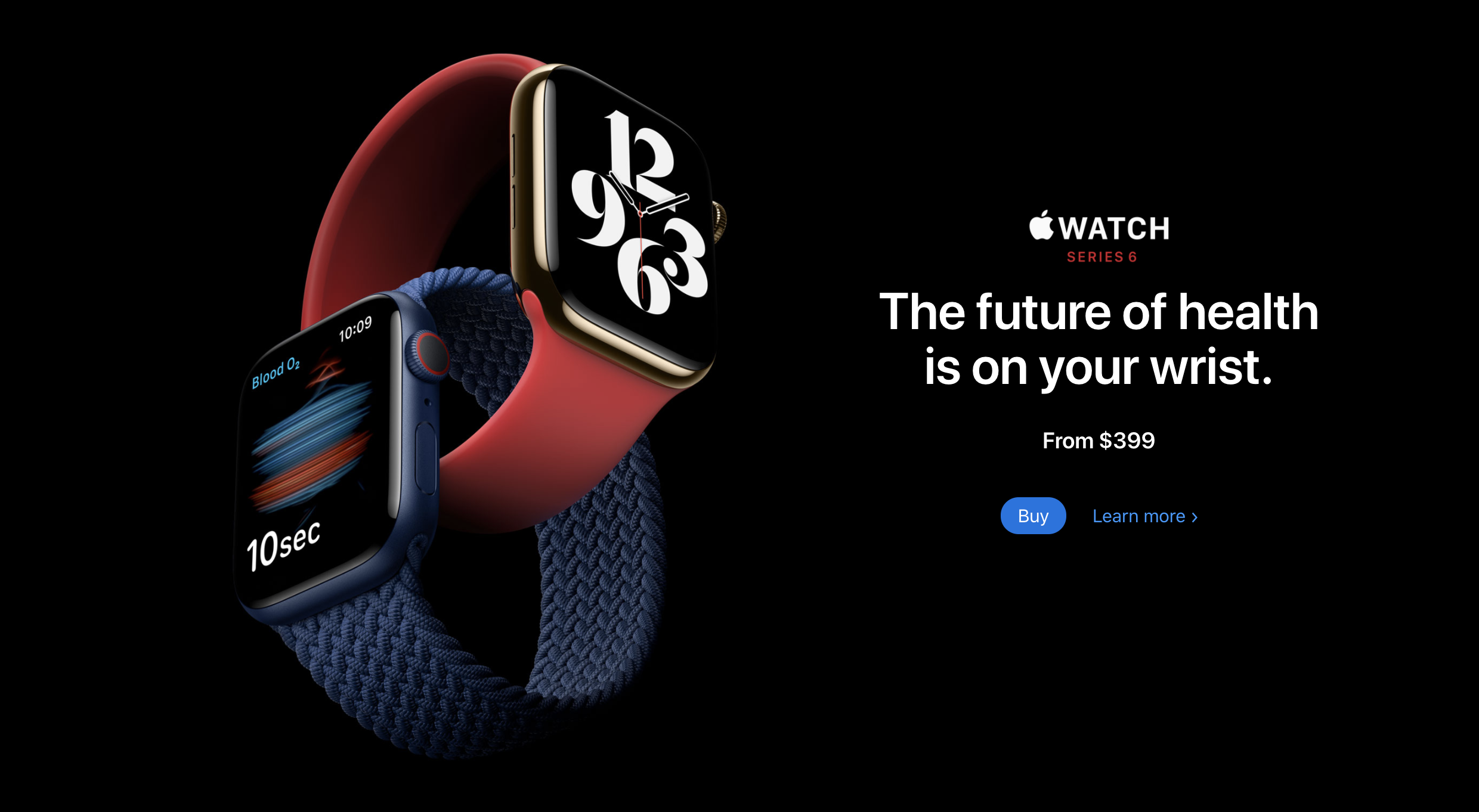
Apple is one of the most successful brands of recent years. Everyone has heard of their brand, they’re familiar with the Apple logo, and they associate the brand with high-end products.
Apple is always looking to break into new markets to make their brand stronger. From personal computers, to iPods, to Watches, to Apple TV, they always aim to be different.
Although they’re a technology firm, Apple also focuses on aesthetics. They build beautiful products that are different from their competitors. Plus, they emphasize the wonderful experience customers can expect when they use an Apple product.
By focusing on the value their desirable products offer, the connection with their consumers, plus strong financial results (revenue and profit), means Apple can build a strong brand moat that makes it hard for competitors to cross.
Coca-Cola

Despite the rise of technology brands, Coca-Cola remains one of the strongest and most famous brands in the world.
But it wasn’t always like this. Coca-Cola had to work hard to make sure they could appeal to different markets outside the US. So, in 2000, they launched their “think local, act local” marketing strategy, which helped make the brand stronger globally.
It’s no surprise that Interbrand’s report noted that presence, authenticity, and commitment were three key factors in Coca-Cola claiming a top spot.
There’s only so much you can say about a soda drink, so Coca-Cola promotes universal values such as happiness, family, and sharing alongside their product messaging.
Nike
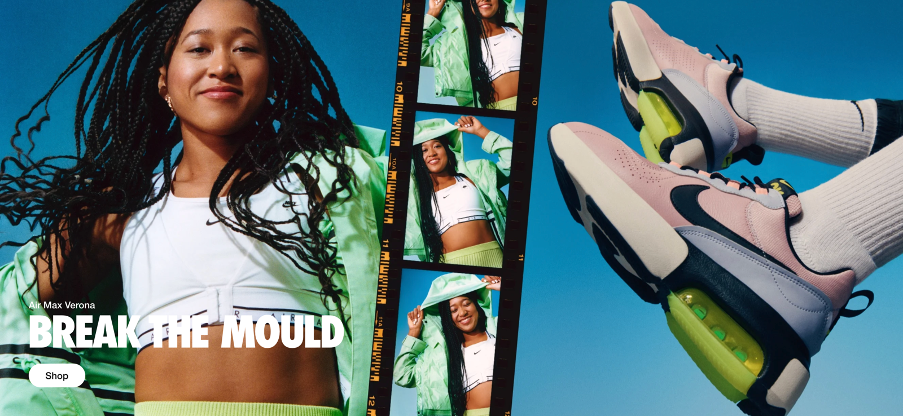
Everyone is familiar with the Nike brand, named after the Greek Goddess of Victory, their “swoosh tick” logo, and their tagline, “Just Do It.”
Nike’s brand has always been focused on the concept of performance and innovation for serious athletes. But nowadays they’re also a fashion brand for any leisure activity.
Although they started with sports shoes, they now offer a full range of performance clothing for different sports, including soccer, tennis, golf, and many more.
But Nike continues to differentiate themselves from their competitors to make their brand even stronger.
For example, they launched the Nike Run Club, a free app that includes guided runs, podcasts, playlists, route tracking, and training plans.
And more recently, they launched their Adventure Club, an online subscription service that provides parents with periodical deliveries of new children’s shoes.
Sitting in 16th place in the Interbrand report, Nike’s three top-performing factors are responsiveness, authenticity, and engagement, as shown in the examples above.
All these examples of companies with strong brands continue to ensure they perform at a high level, branch out into new areas, build a community, and post strong financial results.
How to Optimize Brand Performance
Here are six marketing tactics to improve brand performance.
1. Define Your Target Market
Before you do anything, you must identify and understand your target market.
Ask these questions regarding your product or service:
- What is the age bracket of your current or ideal customer?
- What is the income bracket of your ideal customer?
- Is your product or service gender-specific, or is it for everyone?
- What factors cause customers to complete a purchase?
- What are the desires and needs of your potential customers?
When you know the answers to these demographic and behavioral questions, you’ll be able to position your brand based on what appeals to your primary target market.
You can then personalize your marketing efforts to penetrate the market.
2. Set Campaign Goals
Ad campaigns rely on branded content that engages and inspires your target customers to take action. Before you launch your campaign, you’ll need to set goals based on expected clicks, impressions, leads, and sign-ups, so that you can measure the brand performance.
Based on these results, you can decide which brand elements to use again and which to discard so that you can achieve maximum optimization on your next campaign.
3. Embrace Rich Media Content
Digital marketing and advertising no longer have to rely on one overused static image and text caption.
With cheaper and more intuitive technology, you can now produce rich media content with multiple formats, including podcasts, GIFs, videos, AR, and VR, to attract people’s attention and inspire them to buy.
So, make sure you enhance your branding and messaging across all platforms with the latest rich media content formats.
4. Plan for Mobile Users
As technology advances, audience behavior changes, and more people are using their mobile smartphones to check web content.
- Over 51% of smartphone users have discovered a new company or product while conducting a search on their smartphone.
- 52% of global web page views (and over 61.7% of web page views in Asia) were by mobile phones as of February 2020.
Note: Countries like India skipped the desktop internet phase and went straight to mobile access. But in the US, only around 40% of online traffic is on mobile.
That’s why it’s essential to check your analytics data to determine what proportion of visitors are using mobile smartphones and tablets to access your marketing channels, including websites, social networks, and paid advertising.
Make sure you’re optimizing content for smartphones and tablets.
5. Don’t Forget Voice Search
With the rise of Apple’s Siri and Amazon’s Alexa, you’ll also want to rethink how people are asking AI-powered “voice assistants” for answers to their questions.
- 50% of all online searches will be voice searches in 2020.
It’s another opportunity to make sure both your organic and paid content, including branded content, address these ultra-specific queries.
6. Use Retargeting
Potential customers don’t always make it through your buyer funnel. But with retargeting, you have another opportunity to put branded content in front of those individuals and reacquaint them with your products or services.
Use insights from previous campaigns to promote content with personalized messages and offers to entice potential customers back. Monitor your brand performance on the retargeting campaign to measure the effectiveness of your brand messaging.
Brand Performance in a Nutshell
Building a strong moat brand is your best line of defense. One that guarantees success in the digital age by generating substantial revenue and healthy profits.
Brand performance allows you to determine precisely how strong your brand is. And by following the right steps, you can measure and optimize your brand performance so that you can grow a strong brand and profitable business.



